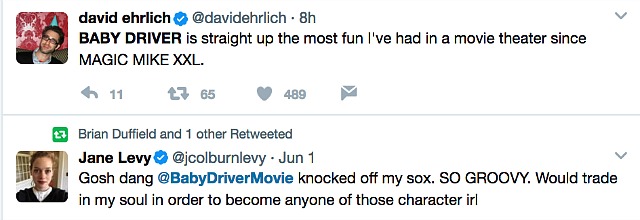A little more than a month ago a N.Y. Times piece, reported by Alexander Burns and Jonathan Martin, assessed a list of possible contenders for the 2020 Democratic Presidential nomination. It boiled down to an oldsters vs. youngsters thing — the well-branded, 70-plus trio of Sen. Elizabeth Warren, Sen. Bernie Sanders and former vp Joe Biden vs. the 40ish fraternity of California Lieutenant Governor Gavin Newsom (my favorite) plus Senators Kamala Harris (my first runner-up), Cory Booker (the closet thing shouldn’t matter but will come up), Amy Klobuchar of Minnesota (who?) plus Massachucetts Congressman Seth Moulton (his look and demeanor scream “affable vp pick”).
Day: June 2, 2017
Adapt or Die
The wifi at Hollywood Elsewhere’s Rome apartment (154 via Monserrato) is all but worthless, so I’ve been tapping stuff out at the nearby Barnum Cafe (Via del Pellegrino 87, Rome). A half hour ago the Barnum proprietors told me I’d have to take the Macbook Pro across the street as their place turns into an eating establishment around 8 pm or so. No problem. The wifi is strong enough to extend several feet beyond the cafe’s walls. So here I am, tapping away on a worn-down cobblestoned street that’s been here for at least 2000 years.
One More Time
40 years and six days ago, George Willig became an instant folk hero when he ascended the south tower of the World Trade Center, climbing 110 stories with all the New York-area news channels covering like crazy. It happened on 5.26.77. Apologies for not acknowledging the anniversary until today, but I’ve been running around. Here’s a portion of a piece I ran nine years ago (8.9.08) about Willig and his feat:
“A toymaker and rock-climber from Queens, the 27 year-old Willig had built a special climbing device that utilized the vertical window-washing channels in the corner of the south tower. He began his climb at 6:30 am that morning, and made it to the top three and a half hours later. When he was a little more than halfway up the cops came down on a window-washing scaffold and tried to get him to abandon the climb, but Willig refused. He was arrested when he finished, but public acclaim was so enthusiastic — the N.Y. Daily News headline hailed ‘the Human Fly!’ — that authorities only fined him $1.10, or one cent for every floor.
“I was in the midst of producing a Save the Whales benefit concert in Wilton, Connecticut. I was as blown away by Willig’s stunt as everyone else, and so I decided to invite him to make an appearance at the concert, which was held in a large amphitheatre-like area on property owned by David and Linda Black, the parents of my ex-girlfriend, Sophie Black (who later became a respected poet).
“Willig didn’t say yes or no, but I announced in the Whale concert posters that ‘the Human Fly’ would attend anyway. If he didn’t show I figured I’d just get on the mike and say ‘them’s the breaks.’
“To my surprise, Willig and a couple of friends turned up on the day of the concert — a warm sunny day sometime in mid to late July of ’77 — and took a bow before a totally cheering crowd. It was quite a moment. David Black introduced him by saying Willig ‘believed in something — he believed in himself.’
Billy Joel’s “A Matter of Trust”
I want to believe this, but I just can’t. Twitter raves are always suspect unless they’re coming from someone like myself. Okay, maybe I can accept these as an aggregate chorus but I certainly can’t trust Ehrlich.


What Were They Thinking?
Assess any chapter in 20th Century cinema and it’s easy to point to this or that great film. It’s a little trickier to figure out which great films were honestly and artfully reflecting basic truths about their times. John Ford‘s The Grapes of Wrath, Howard Hawks‘ Scarface, William Wyler‘s The Best Years of Our Lives — that line of country. As opposed to films that shovelled wish-fulfillment bullshit, which, I realize, can deliver a certain kind of roundabout truth.
For me the most lasting and resonant trait of any world-class film is a manifest reflection of the times and culture from whence it came, and almost always in some kind of profound light, or at least with a modest dose of spiritual nourishment or realignment, even if it’s bitter. I’ve always regarded The French Connection as a tangy, highly charged capturing of early ’70s New York City, when things weren’t so great economically or infrastucturally but when pugnacious street attitude and flavor were abundant. Anything but heart-warming, but a great urban film.
Do mediocre films reflect their culture? In some instances, yes. Alas, movie history focuses almost entirely only on the wheat and never on the chaff, and so mediocre stuff is usually forgotten while the great ones live on.
It’s probably too much to ask for a rundown of past films that didn’t reflect well on American culture and/or the film industry (or reflected American culture all too well), but what recent U.S. flicks might qualify in this regard? Films that historians will one day look back upon and go “Jesus God, who were these people? What were they thinking? Who were they deep down? Did they even have a ‘deep down’?”
I’m asking this because of a riff I came across this morning. Posted in late September ’08, the subject was Beverly Hills Chihuahua, a grotesque Middle-American family film that earned $149 million. Here’s the gist:
“The people who will make Beverly Hills Chihuahua (Disney, 10.3) a hit when it opens are are not ‘bad,’ but their support of this film, which I see as a metaphor for the shopping-mall plasticity and icky phoniness that has taken over this country’s middle-class culture, will signify a kind of spiritual tragedy in this country.
“Just as you can look at, say, Snow White and the Seven Dwarfs and say, yup, on some level that was America in 1937, Beverly Hills Chihuahua is a kind of reflection of us.


